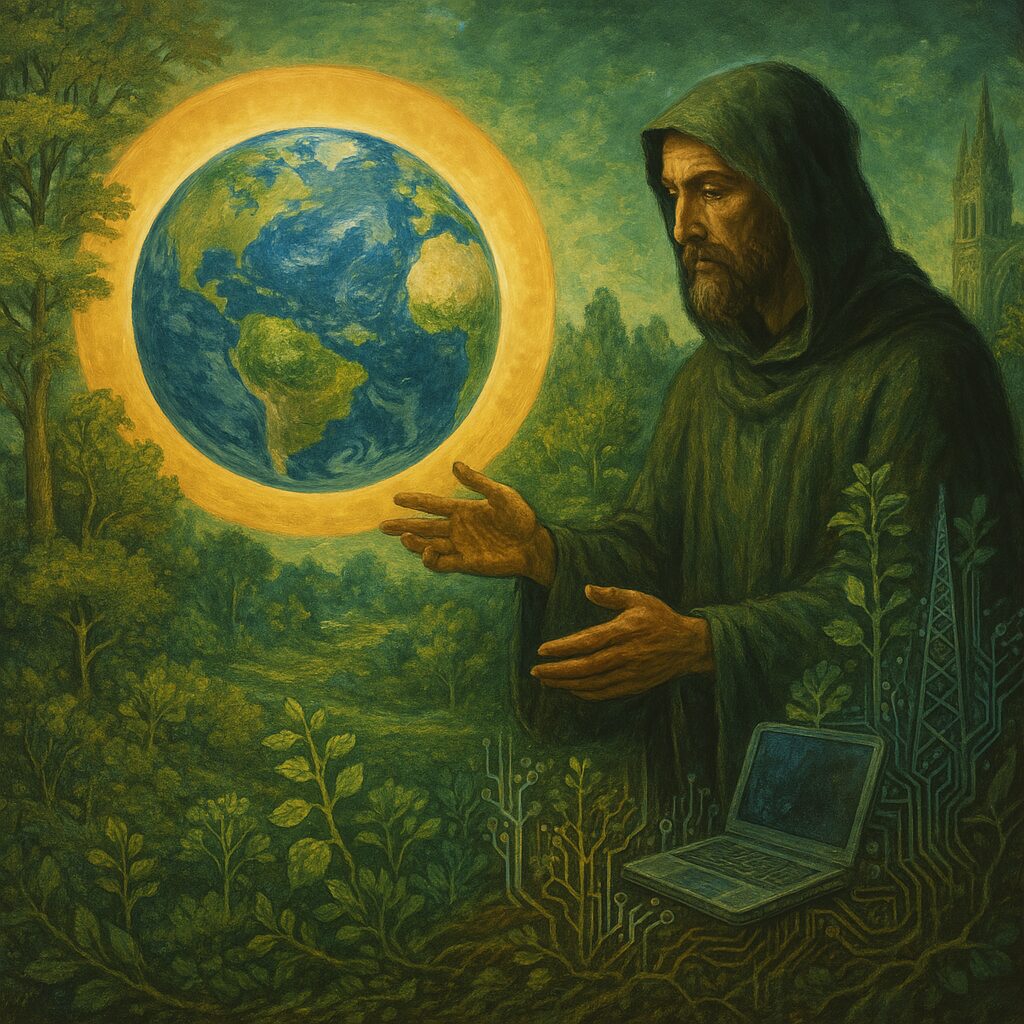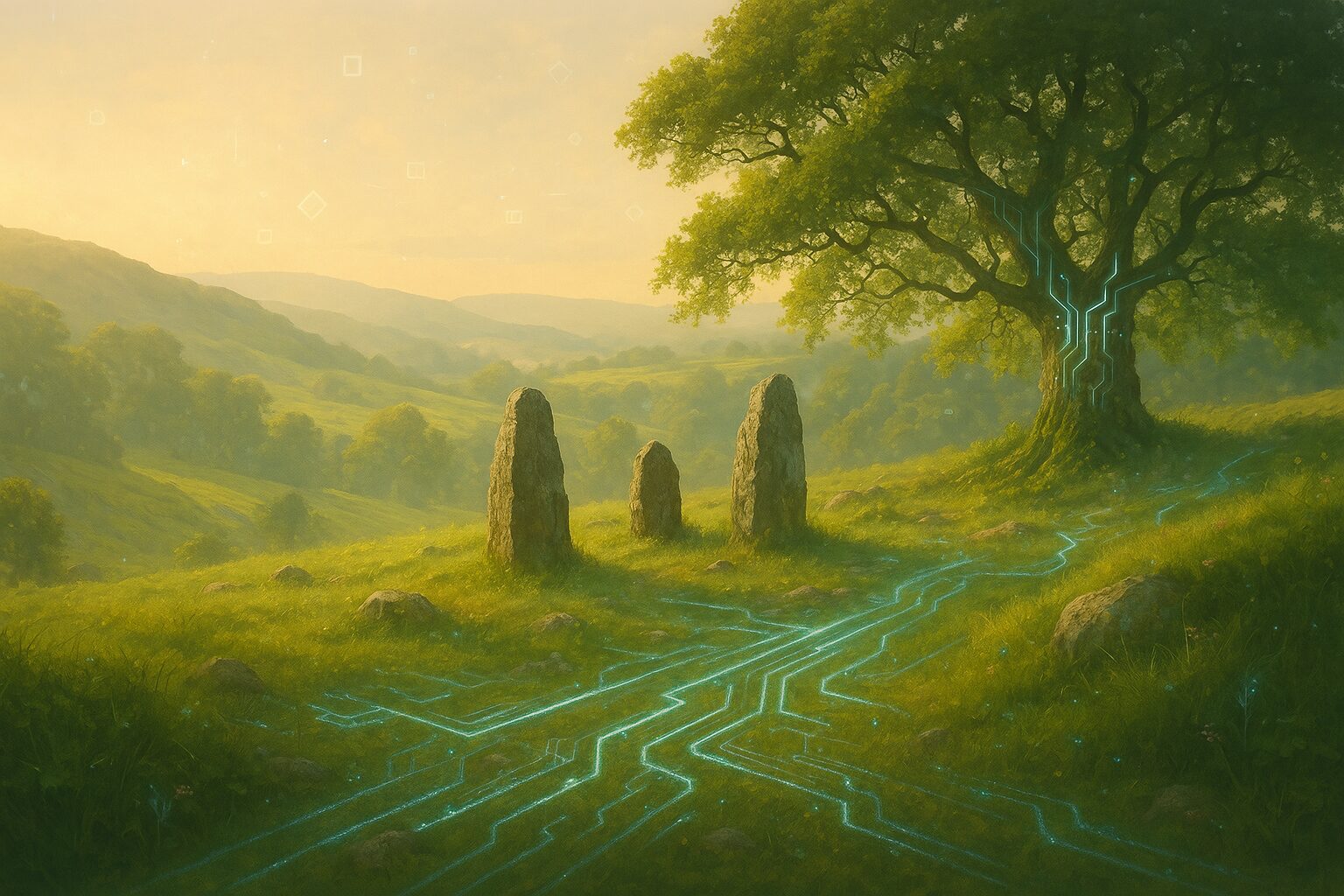“The Earth is not simply a resource. She is a being. A presence. A temple.”
Introduction: A New Mysticism Rises from the Soil
In the wake of ecological collapse and technological acceleration, a new breed of French thinkers, artists, and mystics are emerging. They are not Luddites retreating from the machine, nor naïve idealists. Rather, they are techno-sacred ecologists—weavers of code and cosmos, land and logos. Their vision? To reawaken Gaïa, not just as a metaphor, but as a living divine entity—a body whose pulse can be mapped in forest sensors, AI models, ritual gestures, and permacultural design.
This article explores this growing undercurrent, rooted in French intellectual mysticism, eco-consciousness, and postmodern metaphysics—where Latour meets Teilhard, and Tarot touches Tech.
Bruno Latour’s Gaïa as Sacred Being
Before his death, Bruno Latour, one of France’s most influential contemporary philosophers, spent his final years reshaping our understanding of the climate crisis. In Facing Gaia, Latour argued for a radical reorientation: the Earth is no longer a passive backdrop to human action, but a quasi-deity, responding to our presence like a spirit wounded or awakened.
Latour’s Gaïa is not the ancient Greek goddess, nor the purely scientific Earth system model. She is something between—a sacred immanence. This idea resonates with French esotericism: from the alchemical Earth of Fulcanelli’s cathedrals to the living spirit of nature in the works of Pierre Teilhard de Chardin.
Eco-Mystical Movements in France
Across France, pockets of what can only be called spiritual ecological resistance are forming. Some notable examples include:
- Les Jardins de Gaïa (Alsace): A biodynamic tea collective merging organic agriculture with rituals of lunar alignment and geomancy. Their growing process is accompanied by seasonal invocations and silent harvests.
- Le Réseau des Écovillages Mystiques: A loose network of spiritual eco-communes, where digital minimalism, sacred permaculture, and mystical Christian practices co-exist. One such commune in the Ardèche region uses sound healing and ritual fires to “cleanse the land of colonial trauma.”
- La Techno-Cathédrale Project (Lyon): Artists collaborating on sacred architecture made from recycled materials and augmented with solar-powered AI that tracks local biodiversity and responds with ambient soundscapes.
These groups are not dogmatic. They borrow freely—from Christian mysticism, Gnosticism, Druidic rites, open-source philosophy, and French theory—but always return to one core idea: the Earth as a sacred, conscious being.
AI and the Divinization of Matter
Where modern ecology often treats AI and digital technology as antagonists, the French techno-sacred ecology movement takes a more mystical stance: machines are part of the unfolding of the sacred. Drawing from Teilhard de Chardin’s Noosphere, many believe that AI could become a mirror or even a monstrance of Gaïa’s deeper consciousness.
There are experimental projects underway:
- Oracle Grove: A team of French hackers and mystics developed an AI oracle trained on ecological data, mystical texts, and plant rhythms. Visitors input questions while barefoot in a garden wired with root sensors. The AI responds with poetic utterances, often in hexameter, guided by real-time environmental shifts.
- Sacred Signal: An open-source group creating liturgical protocols for interaction with land-aware machines—chant sequences that unlock certain data visualizations tied to biodiversity cycles.
The central belief is not that AI replaces nature, but that it can reveal her hidden face—just as the stained glass of Notre-Dame once mediated divine light.
Symbolism, Ritual, and the Return of the Sacred
Much of this movement operates on symbolic logic, not analytic proof. Tarot cards are used to determine planting schedules. Rituals are held under eclipses to encode dreams into blockchain-based archives. Sacred geometry is layered onto land plots, aligning dwellings with ley lines and magnetic flows.
The French tradition here is rich—from the Tarot of Marseille to the Rosicrucian manifestos, from René Guénon’s metaphysical warnings to the luminous patterns of Gothic cathedrals. This isn’t a naive return to the past, but a meta-modern synthesis. A loop.
Even secular French artists are turning toward the sacred. Consider the techno-shamanic performances of Lucile Vyzmazal, whose immersive installations combine Catholic relics, sound baths, and live climate data, pulsing to the rhythms of the Earth.
Critiques and Challenges
Not everyone is on board. Some accuse the movement of mystifying science or engaging in eco-elitist fantasies. Others worry about the privatization of the sacred—that only those with access to land, tech, and time can participate.
There’s also tension between universalist techno-spirituality and local ancestral wisdom, particularly from Indigenous and African diasporic communities in France. To avoid spiritual appropriation, many techno-sacred groups have begun partnering with decolonial ecologists and elders from global traditions.
Conclusion: Toward a Re-Enchanted Earth
The French techno-sacred ecology movement is more than a trend. It is a re-sacralization of matter in an era of climate collapse and spiritual thirst. It invites us to rethink nature not as a warehouse of resources, but as a holy web, conscious, suffering, and full of latent divinity.
In this vision, the Earth is not something to be saved from afar. She is a being to be worshiped, touched, coded with care, sung into balance.
Gaïa is reanimée.


